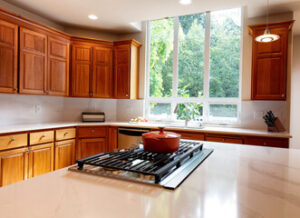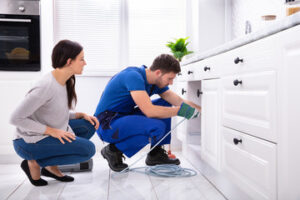Cabinet Refinishing San Jose CA is a great way to give your cabinets an instant facelift! This process is less expensive than refacing and a great alternative to replacing your cabinets.

It’s important to note that refinishing only changes the color of your cabinets, not the door style or wood species. Refinishing also does not address structural damage or blemishes.
Cabinets are a kitchen staple, and there comes a time when you need to give them a facelift. Luckily, there are multiple options for doing so without replacing them entirely: refacing and refinishing. Both offer an updated appearance for your cabinets, but refinishing is a much more cost-effective option than refacing.
Refinishing involves staining or painting your existing cabinets, which means that you aren’t changing their design or layout. It is a surface-only refurbishment that can be done on wood, laminate, or veneer cabinets. It is also a great option for those who don’t want to commit to a total redesign.
The preparation phase of cabinet refinishing is key for achieving the best results. It includes sanding down the cabinets and applying a primer to prevent chipping. This step can be messy and tedious, but it is essential if you want your new finish to last. It’s also important to protect surfaces around the cabinets from dust and other debris during this process. Finally, it is helpful to label cabinet doors so you don’t accidentally return the wrong door to its original place.
Choosing the right paint for your cabinets is another crucial component of the refinishing process. Most people assume that any type of paint purchased at a home improvement store will be the best choice, but this is not always true. In fact, most store-bought paints are not formulated to withstand the natural oils in your skin, which can cause them to chip and peel over time. Professionally applied paint is typically a better choice for cabinet refinishing, as it will last longer and be easier to maintain.
Once the sanding and primer stages are complete, it’s time to start applying your chosen color. Refinishing can be a difficult task, but it is possible to do with the right skill set and tools. Whether you are going from light to dark or from a traditional look to something modern, you’ll need to take your time and be careful not to miss any spots. With the right amount of patience and care, you can achieve your dream cabinets with refinishing.
Stripping
Stripping involves using a chemical solution to soften and dissolve the existing finish. This method is effective at removing multiple layers of paint in one application and can be done indoors as long as the proper safety equipment is used. Chemical stripping can produce strong and harmful fumes, so it is important to work in a well-ventilated area and wear protective gloves and goggles.
The type of stripper used will depend on the specific project at hand. Citristrip is a common option that will remove most paint and varnish in 15 minutes, but can take longer for some thicker finishes. This product can also damage wood, so it is important to read the manufacturer’s instructions carefully. Once the desired amount of stripping has been achieved, the product should be removed with a scraping tool. Afterwash should be used as a final step to clean the piece and eliminate any residue from the stripper.
If you are unsure of which chemical stripper to use for a particular piece, it is always best to consult a professional cabinet refinisher or painter. They will be able to recommend the safest and most effective solution for your specific needs. It is also important to determine whether the piece you are working on has veneer wood – if it does, some of the stripping solutions will damage it.
When using chemical strippers, be sure to follow the manufacturer’s instructions for use and work in a well-ventilated environment. It is also a good idea to wear protective gloves, goggles, and a mask to avoid breathing in the chemicals. In addition, it is a good idea to cover any flooring or workspace with a disposable drop cloth.
Stripping is a messy and time-consuming process, but with the right supplies and preparation can be done in most any home. The biggest expense for refinishing is the labor, which can be expensive depending on the size of your kitchen and how much work you want to do yourself. Hiring a local cabinet painting company can save you money and ensure high-quality results for your kitchen renovation.
Painting
Painting is the final step of cabinet refinishing and can be done by professional or DIY remodelers. It can take anywhere from two to three weeks to complete and is a labor-intensive process that requires careful attention to detail, sanding between coats, and taping off edges and walls. While it may not add as much value to your home as a refacing job, painting is still an important part of any kitchen remodeling project that can increase the overall value of your home.
Painting cabinets is also a way to modernize your existing kitchen and give them a new look without spending a fortune on replacement doors. If your cabinets are in good condition, but they have an outdated color, a fresh paint job can brighten them up and make the entire room feel more modern.
Whether painted or wood, cabinets can get scratched and worn over time, especially if they are exposed to direct sunlight. A fresh repaint will help to hide these scratches and keep your kitchen looking beautiful for years to come.
The best part about refinishing is that it can be done on wood or painted cabinets, unlike refacing, which is only suitable for those with existing laminate and thermofoil doors. It is not possible to reface cabinet doors made from melamine or thermofoil as these materials can’t be sanded and are not compatible with a stain or paint job.
Another benefit of refinishing is that it doesn’t require the same amount of work and expense as a refacing job. If you want to give your kitchen a facelift, but don’t have the budget to buy all-new cabinets, refinishing can be the perfect solution.
Whether you’re refacing or refinishing, the end result should be a more modern kitchen that will increase your home’s value and give it a boost in curb appeal. If you are ready to sell your home, a remodel that includes a new kitchen is always going to attract buyers and bring in a higher price for the property. While a full-scale kitchen remodel is often more expensive than refacing or refinishing, it can also be significantly more time consuming.
Finishing
Cabinet refinishing can be a great way to update your kitchen without spending thousands of dollars on a full remodel. During this process, your existing cabinet doors and fronts are removed carefully to be chemically stripped, sanded, and repainted or re-stained with a new color. The resulting finish can make your cabinets look brand-new.
The main advantage of refinishing is that you’ll save money and avoid the hassle, mess, and expense of replacing your cabinetry completely. Cabinet refinishing is also more environmentally-conscious, as your old cabinets don’t have to be discarded and replaced with something new. However, cabinet refacing offers a more complete transformation of your cabinetry since it involves completely replacing the cabinet skins and hinges and handles.
In addition to saving you money, refinishing your cabinets can also give your space a fresh new look by removing scratches and dents. It’s important to understand the differences between refacing and refinishing to determine which option is best for your needs.
During the refinishing process, you’ll need to cover any surfaces you don’t want to get paint on. You’ll also need to protect your countertops, floors, and appliances from dust and debris as you work. The refinishing process can be tedious and time-consuming, especially if you don’t have the right tools or experience. However, when done properly by a professional, your cabinets will last a long time and add years to the life of your kitchen.
If your cabinets are in good condition, refinishing may be the best option for you. This is because it’s the least expensive method of updating your kitchen cabinets and can be completed in a day or two, depending on the size of your kitchen. However, if your cabinets are damaged beyond repair, you’ll need to reface or replace them.
